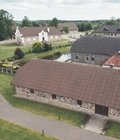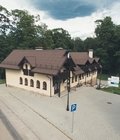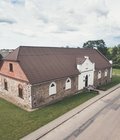Until the end of the 18th century, Plateliai Manor was a property of the Grand Duchy of Lithuania, while later, up to 1940, it used to belong to the family of Choiseul-Gouffier, French counts. In the 19th century, Sofija Tyzenhauzaitė de Choiseul-Gouffier used to live and create here, who was the first woman-author in historic Lithuania who wrote in French. Under Choiseul rule, Plateliai Manor used to be an important centre of Žemaitija’s culture, politics and economy.
Plateliai Manor estate of 19th century – the beginning of 20th century, being an object of architectural and landscaping value, together with the survived buildings (a threshing barn, servant’s quarters, stables, a granary and a cellar) and the park is a state-protected cultural valuable. Part of these buildings are restorated and are adapted to meet public needs. Wooden buildings of the Manor were burnt during the World War II (in 1943).
Plateliai Manor Park started to be formed in the 19th century. Two imposing trees that have been granted the status of monuments of nature grow here – Raganos uosis (Witch’s Ash), Lithuania’s stoutest ash (7.2 m girth) and Platelių liepa (Plateliai linden) (5.4 m girth). The Plateliai Park is a habitat for bats, the largest on the entire territory of the Žemaitija National Park: 7 species of bats have been registered, the major part of which are listed by the Red List of Lithuania. Also, other species of protected plants (Phaeophyscia endophoenicea, Porella platyphylla, Greater butterfly orchid (Platanthera chlorantha) and others) and animals (Great crested newt (Triturus cristatus), Black apollo, Gray-headed Woodpecker (Picus canus) and others) can be seen in the Park.
Near the Park, a former orchard (3.5 ha) of the Manor has survived, in which Platelių vinkšna (Plateliai Elm) (4.8 m girth) grows that has been granted the status of a monument of nature.
 In 2008, Plateliai was awarded a winner destination as a site of tourism and local intangible heritage (An initiative launched by the European Commision "European Destinations of Exellence " - EDEN).
In 2008, Plateliai was awarded a winner destination as a site of tourism and local intangible heritage (An initiative launched by the European Commision "European Destinations of Exellence " - EDEN).






Reviews